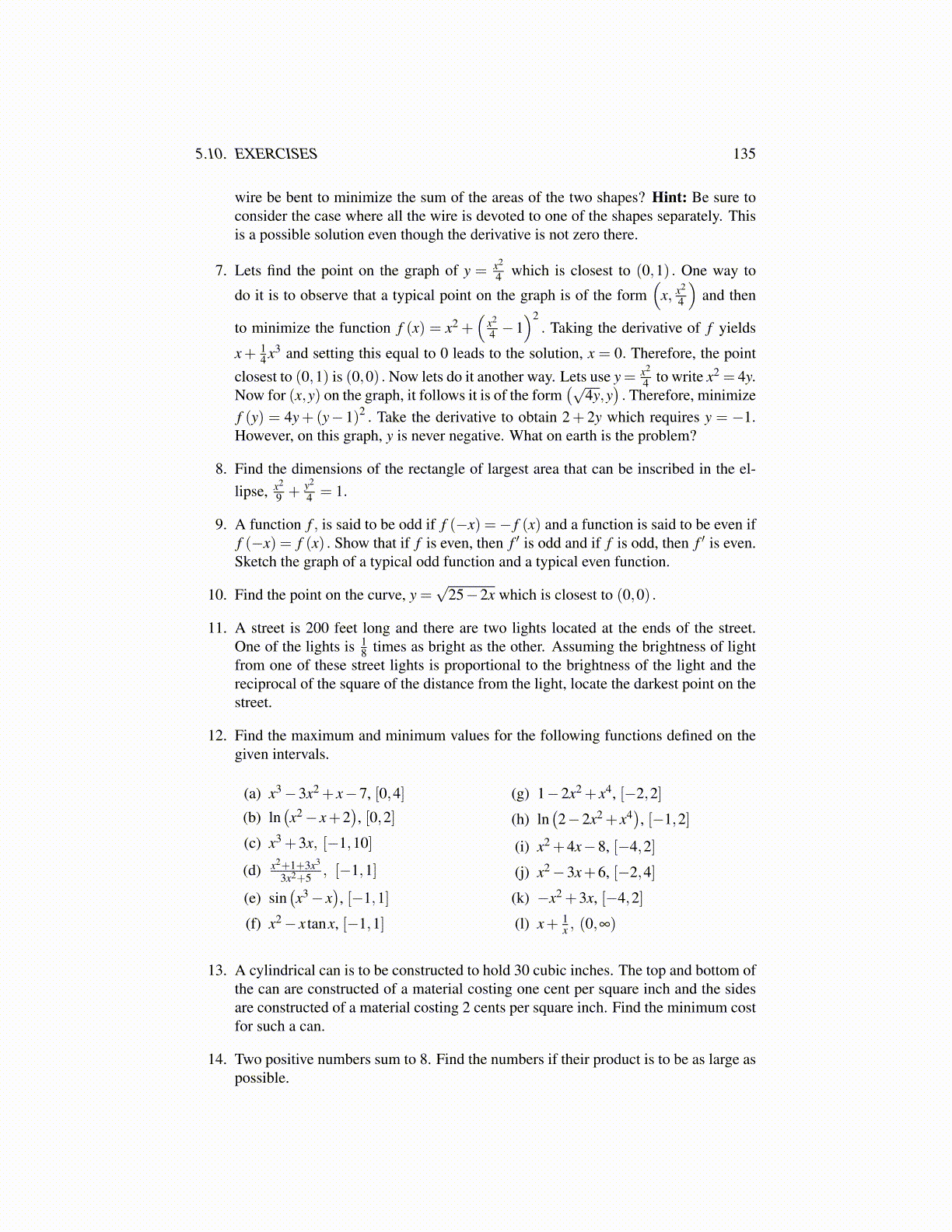
5.10. EXERCISES 135
wire be bent to minimize the sum of the areas of the two shapes? Hint: Be sure toconsider the case where all the wire is devoted to one of the shapes separately. Thisis a possible solution even though the derivative is not zero there.
7. Lets find the point on the graph of y = x2
4 which is closest to (0,1) . One way to
do it is to observe that a typical point on the graph is of the form(
x, x2
4
)and then
to minimize the function f (x) = x2 +(
x2
4 −1)2
. Taking the derivative of f yields
x+ 14 x3 and setting this equal to 0 leads to the solution, x = 0. Therefore, the point
closest to (0,1) is (0,0) . Now lets do it another way. Lets use y= x2
4 to write x2 = 4y.Now for (x,y) on the graph, it follows it is of the form
(√4y,y
). Therefore, minimize
f (y) = 4y+(y−1)2 . Take the derivative to obtain 2+ 2y which requires y = −1.However, on this graph, y is never negative. What on earth is the problem?
8. Find the dimensions of the rectangle of largest area that can be inscribed in the el-lipse, x2
9 + y2
4 = 1.
9. A function f , is said to be odd if f (−x) =− f (x) and a function is said to be even iff (−x) = f (x) . Show that if f is even, then f ′ is odd and if f is odd, then f ′ is even.Sketch the graph of a typical odd function and a typical even function.
10. Find the point on the curve, y =√
25−2x which is closest to (0,0) .
11. A street is 200 feet long and there are two lights located at the ends of the street.One of the lights is 1
8 times as bright as the other. Assuming the brightness of lightfrom one of these street lights is proportional to the brightness of the light and thereciprocal of the square of the distance from the light, locate the darkest point on thestreet.
12. Find the maximum and minimum values for the following functions defined on thegiven intervals.
(a) x3 −3x2 + x−7, [0,4]
(b) ln(x2 − x+2
), [0,2]
(c) x3 +3x, [−1,10]
(d) x2+1+3x3
3x2+5 , [−1,1]
(e) sin(x3 − x
), [−1,1]
(f) x2 − x tanx, [−1,1]
(g) 1−2x2 + x4, [−2,2]
(h) ln(2−2x2 + x4
), [−1,2]
(i) x2 +4x−8, [−4,2]
(j) x2 −3x+6, [−2,4]
(k) −x2 +3x, [−4,2]
(l) x+ 1x , (0,∞)
13. A cylindrical can is to be constructed to hold 30 cubic inches. The top and bottom ofthe can are constructed of a material costing one cent per square inch and the sidesare constructed of a material costing 2 cents per square inch. Find the minimum costfor such a can.
14. Two positive numbers sum to 8. Find the numbers if their product is to be as large aspossible.